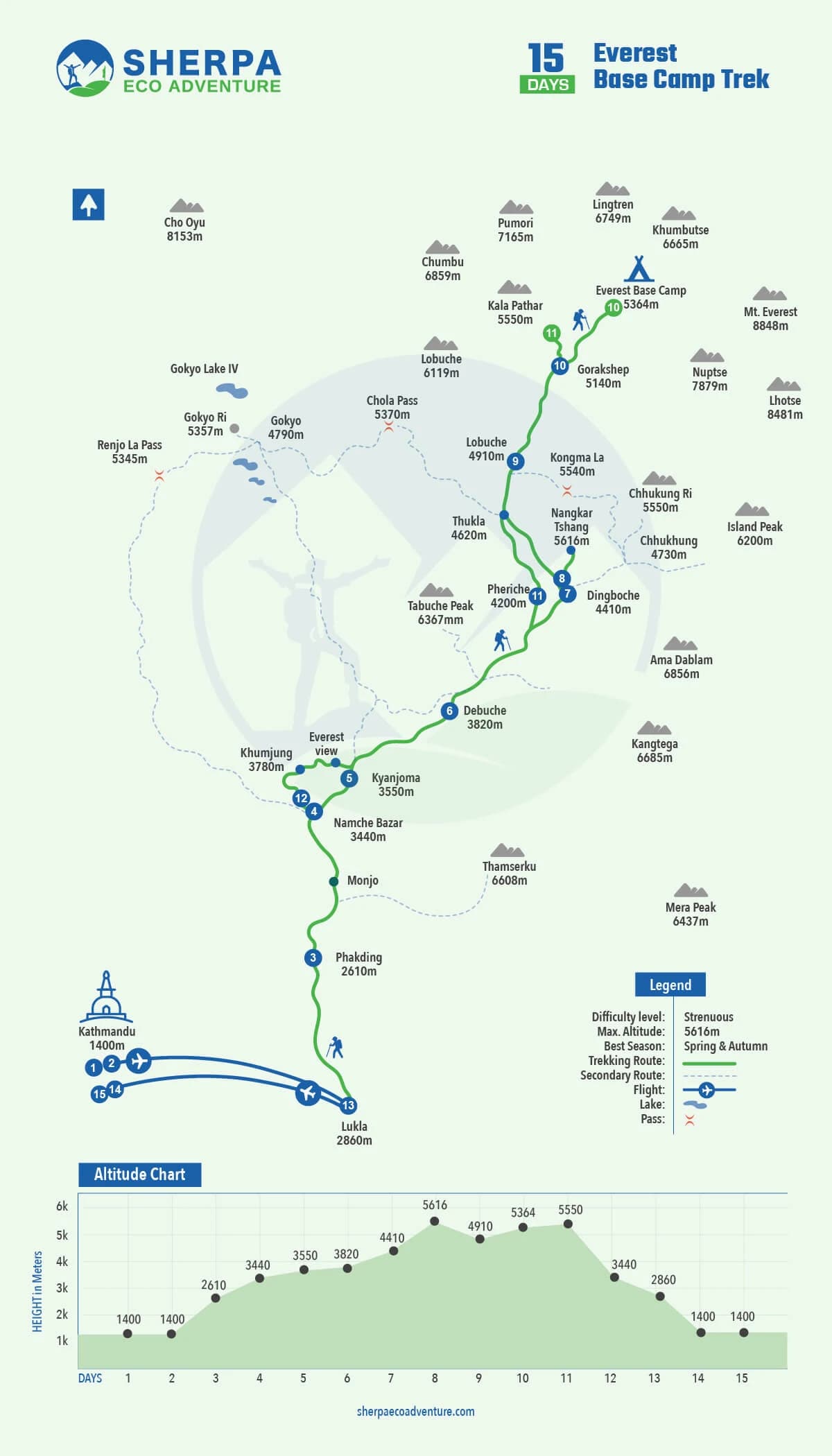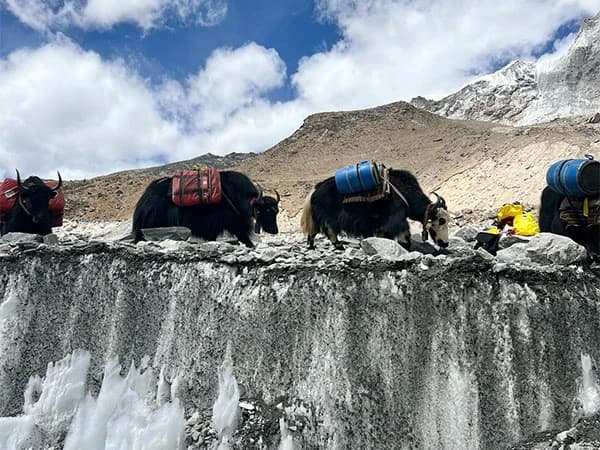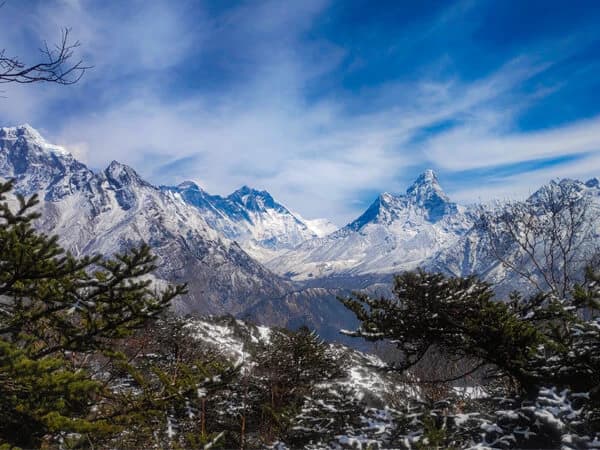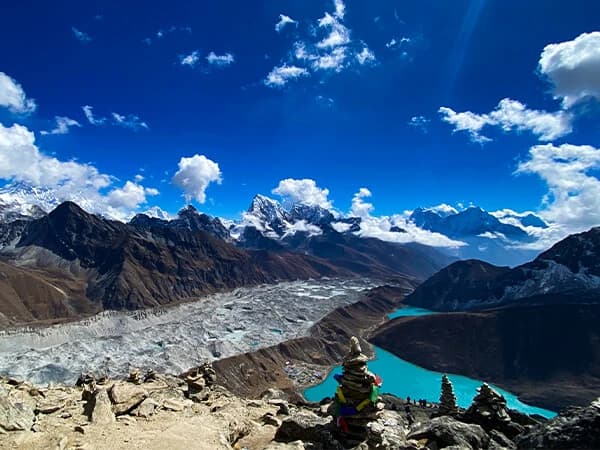Everest Base Camp stands as the quintessential trek and one of the globe’s most sought-after destinations, fulfilling the dreams of countless travelers worldwide. Immerse yourself in a captivating adventure as you embark on the Everest Base Camp Trek, which offers an enthralling and immersive adventure against a stunning, majestic backdrop of the world’s highest peaks.
As adventurers traverse the mesmerizing Himalayan landscapes, they immerse themselves in the genuine Sherpa culture, enjoy heartfelt hospitality, and culminate their journey at the awe-inspiring base of Mt. Everest. This trek presents a comprehensive experience, blending the excitement of high-altitude trekking with the cultural allure of the Everest region.
The Everest Base Camp Trek Thar provides unparalleled views and traces legendary trails. The 14-day journey challenges trekkers but confirms their path when faced with adversity. Everest Base Camp stands as a premier trekking destination, fulfilling global travelers' dreams with an immersive adventure amidst iconic peaks like Mt. Everest, Lhotse, Makalu, and Cho Oyu.
Throughout the Everest Base Camp Trek in Nepal, trekkers traverse diverse ecological zones, encountering varied flora and fauna. Starting in lush valleys adorned with rhododendrons and pine forests, the trail supports wildlife like the Himalayan Thar, musk deer, and nomadic birds in a unique Himalayan ecosystem.
The Everest Base Camp Trek is a pinnacle adventure for Himalaya enthusiasts, offering a hallmarked experience at the world's highest summit. This iconic journey draws both adventure seekers and nature lovers alike. The Everest Base Camp Trek in Nepal includes a unique landing and takeoff experience at Tenzing-Hillary Airport, one of the world's most dangerous airports.
Book our Everest Base Camp Trek 2026 and 2027—now open for booking! Experience stunning Himalayan views, comfortable teahouse stays, and expert support from the best Sherpa guides in Nepal. With customizable itineraries and small group or private options, this is your chance to trek to the base of the world’s highest peak with a trusted local team. “Sagarmatha ko kakhma, ek avismarniya anubhav!” —an unforgettable experience to the foot of Everest. Book now and make your dream adventure a reality!
Highlights
- The highest mountain, Mt. Everest (8848.86 m), is in the world.
- Experiencing Sherpa culture from the origin of the beautiful Sherpa mountain.
- Amazing hike to Hotel Everest View Hotel and Khumjung Village.
- An exhilarating 30-minute scenic flight to Lukla.
- Treating you to breathtaking aerial vistas of the majestic Himalayas.
- Discover the lively Sherpa culture in Namche Bazaar, the capital of Sherpa and the gateway to Mt. Everest.
- Ancient monasteries and awe-inspiring mountain panoramas await exploration.
- Explore the historic Tengboche Monastery, situated at an elevation of 3,900 meters.
- Adventure through the Khumbu Glacier and Gorakshep, a noble settlement.
- Witness the electrifying spectacle of standing at the base of the world’s loftiest summit.
- Ascend to Kalapatthar to capture a breathtaking sunrise viewfinder.
- The variety of ecosystems, high-altitude alpine meadows, and Himalayan wildlife.
- Understand altitude adaptation through the practice of acclimatization.
- Revisit charming villages such as Lobuche, Pheriche, and Namche Bazaar.
- Engage with Sherpa communities, explore monasteries, and discover their distinctive lifestyle amidst the grandeur.
What to expect during the Everest Base Camp Trek?
Embarking on the Everest Base Camp trek offers thrilling adventures for serious trekkers, featuring diverse terrains from lush valleys to high-altitude rocky paths. The journey starts with a scenic flight to Lukla, providing breathtaking Himalayan views.
Everest Base Camp Odyssey offers cultural immersion in Sherpa villages like Namche Bazaar, spiritual experiences at Tengboche Monastery, and acclimatization in Dingboche for a safe altitude ascent. The journey culminates in rugged terrain, leading to the ultimate destination: Everest Base Camp.
Bouldering Kalapatthar satisfies wanderlust with a captivating Everest sunrise. Engage with Sherpas for cultural richness and traverse iconic Himalayan landscapes. This journey offers camaraderie and transformative experiences for Everest Base Camp adventurers.
Is Everest Base Camp right for you?
Determining suitability for the Everest Base Camp entails evaluating multiple factors. Essential is your physical readiness to tackle rugged landscapes and elevated altitudes, requiring regular cardiovascular and strength exercises. Given altitudes exceeding 5,000 meters, assessing your tolerance to such heights is crucial, with the trek including acclimatization periods to mitigate potential hazards.
Whether you're an experienced wanderer or a beginner, prior trekking experience enhances the overall enjoyment of your journey. With a typical trek lasting 12 days, including acclimatization breaks, it's essential to factor in the time commitment. If you're seeking a challenging trek with stunning mountain views and cultural experiences, the Everest Base Camp expedition could be your ideal adventure.
Assess your preference between solo trekking and guided group adventures; engaging a local guide can enhance safety and cultural understanding. Ultimately, the Everest Base Camp trek offers a poignant experience, so aligning your fitness, expertise, and desires is crucial. Consult the travel experts at Sherpa Eco Adventure for valuable guidance.
And if you feel like extending the trek, you can easily combine the Gokyo Trek with Everest Base Camp Trek
Perks of doing the Everest Base Camp trek with us.
Aiming for the Everest Base Camp trek is effortless and worry-free with Sherpa Eco Adventure's expert team by your side. With our steadfast support, you can undertake this journey confidently and securely. Committed to your safety, our dedicated team ensures a seamless and hassle-free Everest Base Camp trekking experience.
Additionally, we’ve outlined some additional benefits you’ll enjoy when trekking in collaboration with the Sherpa Eco Adventure team:
- Attempt your journey with amiable and skilled guides and porters.
- Facilitating all the logistical aspects like permits, accommodation, and transportation, and overseeing all related matters.
- The best Everest Base Camp trekking cost.
- Sherpa Eco Adventure prioritizes safety, with protocols in place for altitude sickness and emergencies, and ensuring trekkers are well-prepared for high-altitude challenges.
- Integrate acclimatization days into the schedule to minimize risks at altitude.
- Flexibility in your itinerary that you can customize
- Assist with renting trekking gear, alleviating the need for trekkers to bring all their gear from home.
- Able to connect with like-minded individuals, fostering camaraderie and mutual support.
- Contribute to sustainable tourism and responsible trekking practices.
- Exceptional service and warm-hearted hospitality.
- Ongoing assistance network from the base.
- Hassle-free experience .
- Transparent pricing with no undisclosed or hidden policies.




